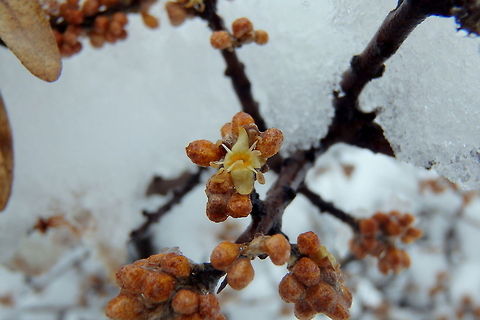Fraxinus pennsylvanica
Fraxinus pennsylvanica
''Fraxinus pennsylvanica'' is a species of ash native to eastern and central North America, from Nova Scotia west to southeastern Alberta and eastern Colorado, south to northern Florida, and southwest to eastern Texas.
It is a medium-sized deciduous tree reaching 12–25 m tall with a trunk up to 60 cm in diameter. The bark is smooth and gray on young trees, becoming thick and fissured with age. The winter buds are reddish-brown, with a velvety texture. The leaves are 15–30 cm long, pinnately compound with seven to nine leaflets, these 5–15 cm long and 1.2–9 cm broad, with serrated margins and short but distinct, downy petiolules a few millimeters long. They are green both above and below. The autumn color is golden-yellow, and the tree is usually the earliest to change color, sometimes being in autumn color as early as Labor Day. The flowers are produced in spring at the same time as the new leaves, in compact panicles; they are inconspicuous with no petals, and are wind-pollinated. The fruit is a samara 2.5-7.5 cm long comprising a single seed 1.5–3 cm long with an elongated apical wing 2–4 cm long and 3–7 mm broad.
It is sometimes divided into two varieties, ''Fraxinus pennsylvanica'' var. ''pennsylvanica'' and ''Fraxinus pennsylvanica'' var. ''lanceolata'' Sarg. Fern.; Green Ash) on the basis of the hairless leaves with narrower leaflets of the latter, but the two intergrade completely, and the distinction is no longer upheld by most botanists.
It is a medium-sized deciduous tree reaching 12–25 m tall with a trunk up to 60 cm in diameter. The bark is smooth and gray on young trees, becoming thick and fissured with age. The winter buds are reddish-brown, with a velvety texture. The leaves are 15–30 cm long, pinnately compound with seven to nine leaflets, these 5–15 cm long and 1.2–9 cm broad, with serrated margins and short but distinct, downy petiolules a few millimeters long. They are green both above and below. The autumn color is golden-yellow, and the tree is usually the earliest to change color, sometimes being in autumn color as early as Labor Day. The flowers are produced in spring at the same time as the new leaves, in compact panicles; they are inconspicuous with no petals, and are wind-pollinated. The fruit is a samara 2.5-7.5 cm long comprising a single seed 1.5–3 cm long with an elongated apical wing 2–4 cm long and 3–7 mm broad.
It is sometimes divided into two varieties, ''Fraxinus pennsylvanica'' var. ''pennsylvanica'' and ''Fraxinus pennsylvanica'' var. ''lanceolata'' Sarg. Fern.; Green Ash) on the basis of the hairless leaves with narrower leaflets of the latter, but the two intergrade completely, and the distinction is no longer upheld by most botanists.
